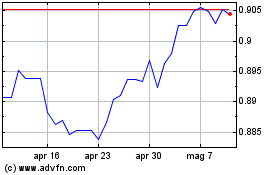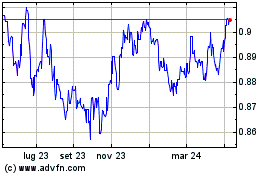Australian Dollar Rises As RBA Holds Interest Rate At 13-Year High
05 Novembre 2024 - 3:06AM
RTTF2
The Australian dollar strengthened against other major
currencies in the Asian session on Monday, after Australia central
bank maintained its interest rate for the eighth straight session
at a 13-year high, as underlying inflation remains too high.
The policy board of the Reserve Bank of Australia governed by
Michele Bullock decided to hold the cash rate target at 4.35
percent. The bank had previously changed its rate in November 2023,
when it was lifted by 25 basis points to the highest level since
late 2011.
The interest rate paid on Exchange Settlement balances was kept
unchanged at 4.25 percent.
The committee said it needs to remain vigilant to upside risks
to inflation and is not ruling anything in or out.
"Policy will need to be sufficiently restrictive until the Board
is confident that inflation is moving sustainably towards the
target range," the bank said.
Data from Judo Bank showed that the services sector in Australia
continued to expand in October, and at a faster rate, with a PMI
score of 51.0. That's up from 50.5.
Following the announcement of the November monetary policy
decision, the Reserve Bank of Australia (RBA) Governor Michele
Bullock said at the press conference the need to maintain
restrictive interest rates for the time being due to ongoing
inflationary risks. Despite a tight labor market, wage growth is
showing signs of easing.
Traders remained cautious and seemed reluctant to make
significant moves ahead of the closely contested U.S. presidential
election later in the day and the U.S. Fed's upcoming interest rate
decision later this week.
The Fed is widely expected to lower interest rates by another 25
basis points, but traders will be looking to the accompanying
statement for clues about the likelihood of future rate cuts.
Crude oil prices rose sharply, buoyed by OPEC's decision to
delay plans to increase production, and on rising concerns about
tensions in the Middle East. West Texas Intermediate crude oil
futures for December closed up $1.98 or about 2.85% at $71.47 a
barrel, extending gains to a fourth straight session.
In the Asian trading now, the Australian dollar rose to 1.6484
against the euro and 100.64 against the yen, from yesterday's
closing quotes of 1.6518 and 100.16, respectively. If the aussie
extends its uptrend, it is likely to find resistance around 1.61
against the euro and 102.00 against the yen.
Against the U.S., the Canada and the New Zealand dollars, the
aussie advanced to 0.6599, 0.9171 and 1.1035 from Monday's closing
quotes of 06584, 0.9152 and 1.1021, respectively. The aussie may
test resistance around 0.69 against the greenback, 0.93 against the
loonie and 1.11 against the kiwi. Looking ahead, S&P Global
publishes final U.K. services Purchasing Managers' survey data for
October in the European session. The final services PMI is seen at
51.8 in October, in line with flash estimate, down from 52.4 in
September.
In the New York session, U.S. and Canada trade data for
September and PMI reports for October, are slated for release.
Grafico Cross AUD vs CAD (FX:AUDCAD)
Da Dic 2024 a Gen 2025

Grafico Cross AUD vs CAD (FX:AUDCAD)
Da Gen 2024 a Gen 2025
